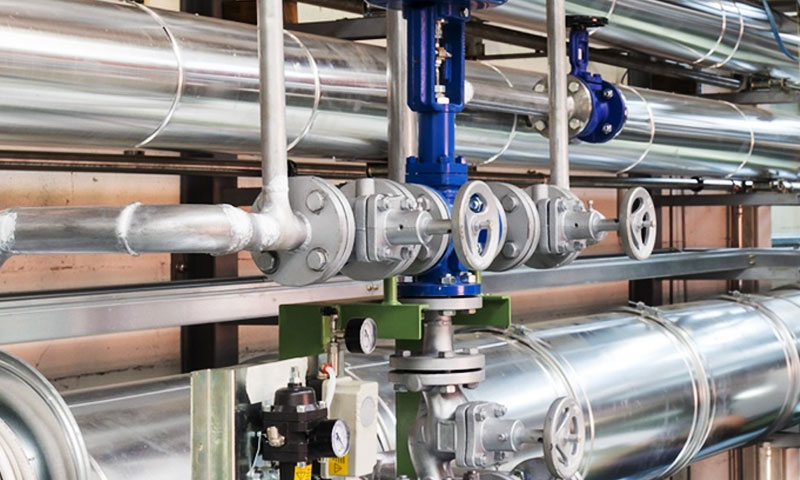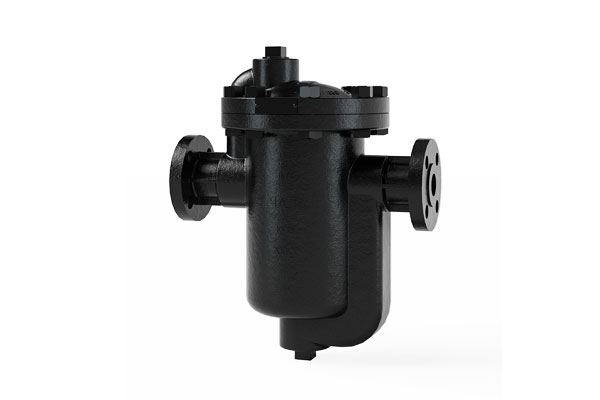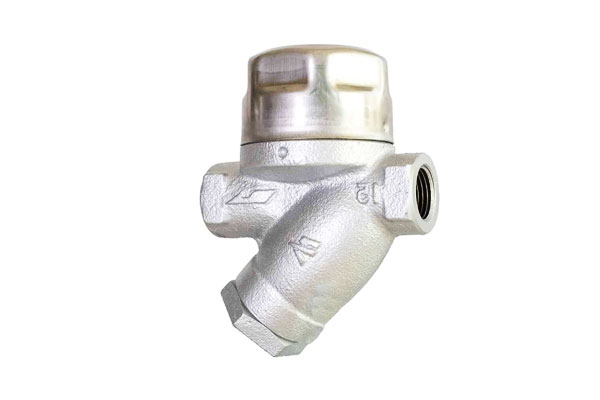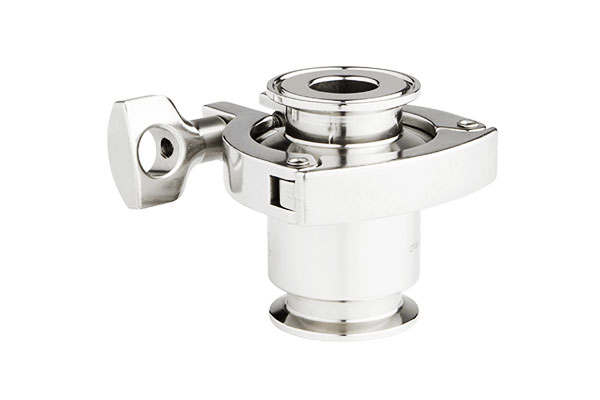1. Perkenalan
A Steam trap is an automatic valve used in steam systems to discharge condensate, udara, Dan non-condensable gases without allowing the loss of live steam.
Acting as critical components in both industrial and commercial steam systems, they ensure thermal efficiency, system reliability, Dan operational safety.
Secara historis, steam traps were rudimentary mechanical devices, but with advancements in materials science, control technologies, Dan energy monitoring,
Modern traps now integrate digital diagnostics and predictive maintenance tools, making them more essential than ever in energy-conscious industrial operations.
2. How Steam Traps Work?
Steam traps are automatic katup that serve a critical role in steam systems: mereka continuously differentiate and expel condensate, udara, and non-condensable gases (NCGs) ketika retaining valuable live steam.
This selective removal is essential for preserving thermal efficiency, equipment longevity, Dan system reliability.
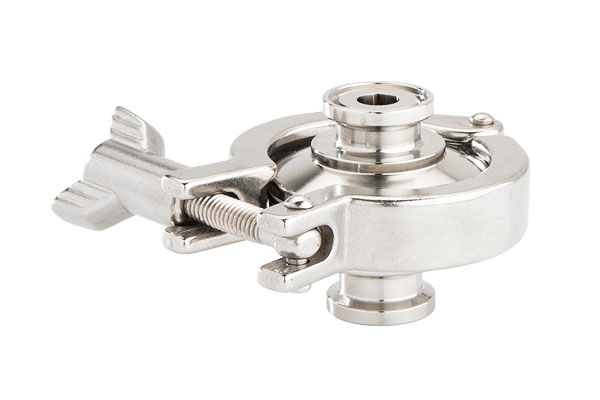
The operation of a steam trap is governed by three fundamental physical property differences between steam, condensate, and gases:
- Density difference
- Temperature difference
- Pressure/velocity difference
These physical distinctions form the basis for the trap’s actuation mechanism—whether mechanical, thermostatic, or thermodynamic.
Core Thermodynamics: Steam vs. Condensate Behavior
Understanding the differences between steam, condensate, and non-condensable gases (NCGs) is essential to comprehending how steam traps function.
Uap
Uap is a high-energy vapor with low density—ranging from approximately 0.5 ke 6 kg/m³ at operating pressures between 1 ke 100 batang.
Its temperature corresponds to the saturation temperature at a given pressure (MISALNYA., 100°C at 1 batang, 184°C at 10 batang).
Steam carries a large amount of latent heat, which makes it highly efficient for thermal processes.
Condensate
Condensate forms when steam releases this latent heat during heat exchange.
It is a dense liquid—typically 900–950 kg/m³—and often cooler than the saturation temperature, dikenal sebagai subcooled condensate.
Under certain conditions, particularly when pressure drops rapidly, condensate can flash into secondary steam, presenting challenges for effective drainage.
Non-condensable gases (NCGs)
Air and non-condensable gases (NCGs), such as oxygen and carbon dioxide, enter the system during startup or form due to corrosion.
These gases are denser than steam but lighter than condensate, and they act as thermal insulators.
If not properly vented, they can reduce heat transfer efficiency by up to 50%, especially in heat exchangers and process vessels.
Essential Functions of a Steam Trap
To maintain steam system performance, a steam trap must reliably perform three key functions:
Efficient Condensate Removal
Accumulated condensate reduces heat transfer surface area and impairs thermal performance.
Misalnya, 25% waterlogging in a heat exchanger can cause up to a 30% drop in thermal efficiency.
Steam traps must discharge condensate immediately upon formation to avoid such losses.
Ventilation of Air and Non-Condensable Gases
During startup, steam systems are filled with air. If not vented, this air causes air locks, blocking steam flow and slowing heat-up.
Because air has very low thermal conductivity (0.026 W/m·K compared to 0.6 W/m·K for steam), it severely impacts efficiency.
An effective steam trap should vent NCGs rapidly—ideally within 10 minutes of startup.
Retention of Live Steam
Live steam contains valuable latent heat (~2,200 kJ/kg at 10 batang). Any steam loss directly translates to wasted energy.
Even a 1% steam leak in a high-pressure system can waste over 1,000 kWh/day.
Karena itu, a high-quality steam trap must seal tightly in the presence of steam, allowing only condensate and gases to exit.
3. Major Types of Steam Trap
Steam traps are categorized primarily based on their operating principles—how they detect and differentiate between live steam, condensate, and non-condensable gases.
The three main categories are:
- Mechanical traps — operate on density differences
- Thermodynamic traps — rely on pressure and velocity effects
- Thermostatic traps — respond to temperature changes
Mechanical Traps
Mechanical traps use the significant density difference between steam and condensate to actuate valve mechanisms.
They generally contain a float or inverted bucket that moves in response to condensate level changes.
Float & Thermostatic (F&T) Traps
- Prinsip kerja:
The core of an F&T trap is a float mechanism inside a chamber. As condensate enters, it fills the trap body, causing the float to rise.
This upward movement is mechanically linked to a valve that opens to discharge the condensate.
When the condensate level falls, the float drops, closing the valve tightly to prevent live steam loss.
Serentak, a thermostatic air vent on the trap’s top removes air and other non-condensable gases by sensing temperature differences: cooler air causes the vent valve to open, while hot steam closes it.
Float & Thermostatic Steam Traps - Advantages of Working Principle:
The float mechanism allows near-continuous condensate discharge at steam temperature, providing excellent thermal efficiency.
The thermostatic vent ensures fast air removal, especially critical during system startup. - Aplikasi:
Widely used in heat exchangers, large process vessels, and other equipment with fluctuating steam loads requiring efficient air venting and reliable condensate drainage.
Inverted Bucket Traps
- Prinsip kerja:
The inverted bucket trap contains a hollow, upside-down bucket suspended inside the trap body.
When condensate fills the trap, the bucket sinks, opening the valve to discharge the condensate.
As steam enters, it fills the bucket, increasing buoyancy and causing the bucket to rise. This upward movement closes the valve, preventing steam from escaping.
The trap cycles between these two states based on the presence of steam or condensate, producing intermittent discharge.
Inverted Bucket Traps - Karakteristik utama:
The cyclic operation effectively handles large condensate loads and provides a robust mechanism less prone to wear due to fewer moving parts.
Namun, the bucket must be primed with condensate during startup for proper operation. - Aplikasi:
Ideal for steam mains, drip legs, and other locations with steady steam pressure where intermittent discharge is acceptable.
Thermodynamic Traps
Thermodynamic traps operate based on the dynamics of pressure and velocity differences between steam and condensate, utilizing Bernoulli’s principle and momentum changes.
Cakram (Snap) Traps
- Prinsip kerja:
The disc trap features a flat metal disc sitting on a valve seat. When condensate enters the trap, it lifts the disc slightly, allowing discharge.
Namun, as flash steam forms beneath the disc due to pressure drop and high velocity, it creates a high-velocity jet and reduced pressure under the disc.
This dynamic effect forces the disc down against the seat, closing the trap tightly.
When condensate cools or pressure conditions change, the disc lifts again, repeating the cycle rapidly. The rapid opening and closing (snap action) make the disc trap very responsive.
Disc Traps - Keuntungan:
This design is compact, rugged, dan memerlukan perawatan yang minimal. It can tolerate dirt and scale better than many mechanical traps and works well under superheated steam conditions. - Batasan:
The snap action can cause noise (chatter), and disc traps may perform poorly at very low loads or pressures. - Aplikasi:
Commonly used on steam mains, long steam tracing lines, and outdoor installations where robustness and freeze resistance are important.
Thermostatic Traps
Thermostatic traps rely on the difference in temperature between live steam and condensate (or air) to open or close the valve.
They use temperature-sensitive elements that physically deform with heat.
Bimetallic Element Traps
- Prinsip kerja:
These traps incorporate a bimetallic strip made from two metals with different thermal expansion coefficients.
When cooler condensate or air contacts the bimetallic element, it contracts or bends, opening the valve to discharge fluids.
As steam at saturation temperature reaches the trap, the element heats up, causing it to expand or straighten, which closes the valve to retain live steam.
This action is gradual and temperature-dependent, allowing precise control based on thermal conditions.
Bimetallic Element Steam Traps - Aplikasi:
Particularly suited for high-pressure steam systems and superheated steam where accurate temperature control is required, such as sterilizers and autoclaves. - Keuntungan & Batasan:
Durable and capable of handling wide pressure ranges, but they may have slower response times compared to mechanical traps and can have difficulty with very low condensate loads.
Balanced Pressure (Expansion Element) Traps
- Prinsip kerja:
A fluid-filled capsule or bellows expands when heated by steam, closing the discharge valve.
When condensate or air cools the capsule, it contracts, opening the valve to discharge fluids.
Because the capsule is filled with an incompressible liquid, it maintains the valve closed even if system pressure fluctuates, hence the name “balanced pressure.”
Balanced Pressure Traps - Aplikasi:
Used for steam tracing, sterilisasi, and smaller heat exchangers where smooth, quiet operation is desirable. - Keuntungan & Batasan:
Excellent at venting air and non-condensable gases, but can be sensitive to water hammer and may require replacement of the capsule element after prolonged use.
Ikhtisar Perbandingan
| Aspek | Mekanis (F&T, Bucket) | Thermodynamic (Cakram) | Thermostatic (Bimetallic, Ekspansi) |
| Control Principle | Kepadatan (liquid level) | Pressure/velocity (dynamic forces) | Suhu (ekspansi termal) |
| Condensate Discharge | Kontinu (F&T) or intermittent (bucket) | Rapid cycling intermittent | Temperature-dependent, gradual |
| Air Venting Capability | Bagus sekali (F&T with thermostatic vent) | Poor without special venting | Bagus sekali |
| Dirt and Scale Tolerance | Bagus (especially bucket type) | Tinggi (robust disc) | Sedang |
| Kesesuaian aplikasi | Process equipment, Penukar panas | Steam mains, tracers, outdoor | Tracing, sterilisasi, sensitive equipment |
| Response to Load Changes | Fast and stable | Can be noisy, less stable at low load | Sedang, temperature lag may delay response |
| Freeze Resistance | Sedang | Tinggi | Rendah hingga sedang |
4. Selection Criteria of Steam Trap
Selecting the appropriate steam trap for a given application is critical to ensure optimal system performance, energy efficiency, and equipment longevity.
The selection process must consider multiple factors that influence trap operation, daya tahan, dan pemeliharaan.
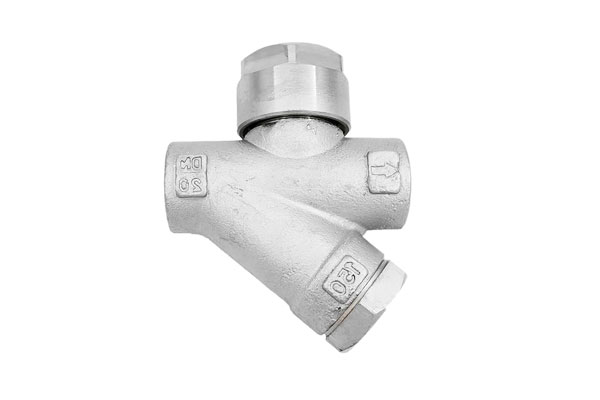
Operating Pressure and Temperature Ranges
- System Pressure:
Steam traps must be rated to handle the maximum and minimum operating pressures of the steam system.
Mechanical traps, such as float traps, perform reliably across a broad pressure range (from low to very high pressures), while thermodynamic traps are generally better suited for moderate to high pressures but may underperform at very low pressures. - Temperature Conditions:
The trap material and type must tolerate the steam saturation temperature and potential superheated steam conditions.
Thermostatic traps excel in handling superheated steam, whereas some mechanical traps may be affected by temperature extremes.
Required Condensate Capacity
- Condensate Load:
The trap must accommodate the maximum condensate flow rate, typically expressed in kg/h or lb/h.
Undersized traps risk flooding and waterlogging; oversized traps may cycle inefficiently or cause steam loss. - Load Variability:
Systems with fluctuating condensate loads benefit from traps with responsive mechanisms (MISALNYA., float traps) to avoid continuous steam loss or condensate buildup.
Karakteristik Cairan
- Corrosion and Contaminants:
Steam systems may contain corrosive substances or particulate matter from boiler blowdown or process fluids.
Traps constructed from corrosion-resistant materials (baja tahan karat, perunggu) are preferred in such environments.
Selain itu, dirt-tolerant designs (MISALNYA., thermodynamic traps) reduce failure risks. - Flashing and Subcooling:
Condensate flashing occurs when high-temperature condensate experiences a pressure drop, producing secondary steam.
Traps must handle the increased volume of flashing steam without misfiring or leaking.
Cycle Rate and Response Time
- Cycle Frequency:
High cycle rates demand traps capable of rapid opening and closing without excessive wear (disc traps are well-suited here).
Sebaliknya, continuous discharge traps like float types provide smooth flow for steady loads. - Response to Air and Non-condensable Gases:
Effective venting of air and NCGs, especially during startup, reduces energy losses and protects heat transfer surfaces.
Traps with integrated thermostatic air vents or combined functions are ideal in these cases.
Material Compatibility and Corrosion Resistance
- Pemilihan materi:
Steam traps are typically made from baja karbon, baja tahan karat, perunggu, atau besi cor. The choice depends on steam quality, kondisi pengoperasian, dan paparan kimia.
Stainless steel traps offer superior corrosion resistance and longer service life but at a higher initial cost. - Faktor lingkungan:
Outdoor or freeze-prone installations require traps designed with freeze resistance or suitable insulation.
Lifecycle Cost Analysis (CAPEX vs. OPEX)
- Investasi awal (CAPEX):
Some trap types have higher upfront costs (MISALNYA., stainless steel float traps) but may offer better durability and reliability. - Operating Expenses (OPEX):
Energy losses from steam blow-through, frequent maintenance, or premature trap failure increase operating costs.
A high-efficiency trap with low failure rates can reduce OPEX significantly. - Maintenance and Accessibility:
Selection should factor in ease of inspection, pembersihan, and part replacement to minimize downtime and labor costs.
5. Installation Best Practices of Steam Traps
Proper installation of steam trap is critical to achieving optimal performance, umur panjang, and energy efficiency.
Even the best-designed steam trap can underperform or fail prematurely if installed incorrectly.

Piping Arrangements: Horizontal vs. Vertical Runs
- Orientation Matters:
Most mechanical steam traps, such as float and inverted bucket types, memerlukan horizontal installation to ensure correct operation of floats or buckets, which depend on gravity and liquid level changes.
Installing these traps vertically or at steep angles can cause malfunction or steam loss. - Thermodynamic and thermostatic traps are less sensitive to orientation and can often be installed vertically or horizontally, offering more flexibility in tight or complex piping layouts.
- Inlet and Outlet Piping:
The inlet pipe should be adequately sized to prevent pressure drops and ensure smooth condensate flow to the trap. Avoid undersizing, which can cause condensate backup.
The outlet piping should be sized to handle the maximum expected discharge and should maintain a downward slope to facilitate condensate drainage and avoid water hammer.
Use of Inlet and Outlet Accessories
- Strainers:
Install strainers or dirt legs upstream of the steam trap to protect the internal valve from dirt, skala, and debris.
Clean or replace strainers regularly to prevent clogging and ensure trap longevity. - Isolation Valves:
Incorporate isolation valves on both the inlet and outlet sides of the trap. This allows easy removal and maintenance without shutting down the entire steam system. - Drip Legs:
Place drip legs or separators ahead of traps to collect large volumes of condensate or slugs of water, preventing trap damage from water hammer.
Proper Pitch and Positioning
- Trap Position Relative to Equipment:
Install traps as close as possible to the equipment outlet or drip point to prevent condensate accumulation, which can cause waterlogging and reduce heat transfer efficiency. - Piping Slope:
Maintain a minimum pipe pitch of 1:100 (1% slope) toward the trap to ensure condensate flows freely by gravity.
Insufficient pitch leads to condensate pooling in steam lines and may result in water hammer. - Trap Discharge Position:
The trap outlet pipe should also be sloped downward and routed to the condensate return system or drain.
Avoid long horizontal runs after the trap outlet to prevent backpressure buildup.
Ensuring Accessibility for Inspection and Maintenance
- Accessible Location:
Steam traps should be installed where they are easily accessible for inspection, pengujian, and maintenance without requiring extensive system shutdowns or personnel risk. - Space for Tools:
Provide sufficient clearance around the trap to allow removal, penggantian, or cleaning of components. - Labeling and Documentation:
Clearly label all steam traps with identification numbers, service dates, and trap type.
Maintain updated schematics and maintenance logs to streamline troubleshooting and record keeping.
Additional Considerations
- Thermal Insulation:
Insulate steam traps and associated piping to minimize heat loss and prevent freezing in cold environments. Use insulation materials suitable for the operating temperature and conditions. - Condensate Return System Compatibility:
Ensure the trap outlet discharges into a condensate return system or suitable drainage with adequate capacity and pressure rating. - Water Hammer Prevention:
Proper sizing, melempar, and trap selection are vital to mitigate water hammer risks. Water hammer can severely damage traps and piping, causing premature failure.
6. Pengujian, Commissioning & Pemeliharaan
Ensuring steam traps operate efficiently and reliably throughout their service life requires systematic testing, careful commissioning, and regular maintenance.
Proper procedures minimize steam loss, prevent equipment damage, and optimize energy consumption.
Pre-Startup Testing
- Bench Testing:
Before installation, steam traps should undergo bench testing according to manufacturer specifications.
This confirms the trap’s operational integrity, including valve seating and float or disc movement.
Bench tests simulate operating conditions and help detect manufacturing defects or damage incurred during shipment. - Leak and Pressure Tests:
After installation, perform pressure tests to verify there are no leaks in the trap body, connections, or associated piping. Ensuring tight seals prevents steam loss and system inefficiencies. - Functional Verification:
Verify correct trap orientation and ensure inlet/outlet valves and strainers are properly installed and open.
Online Diagnostic Techniques
- Pengujian ultrasonik:
Ultrasonic devices detect the high-frequency sound generated by steam or condensate flowing through the trap.
By analyzing flow patterns, technicians can determine if the trap is discharging condensate properly or if it is leaking steam. - Thermal Imaging (Infrared Thermography):
Thermal cameras identify temperature differences across the trap.
A functioning trap typically shows a temperature gradient between the inlet (hot condensate/steam) and outlet (discharged condensate).
Abnormal thermal profiles may indicate blockages, leaks, or failed components. - Differential Pressure Measurement:
Measuring pressure drop across the trap helps assess flow characteristics and trap condition. Excessive pressure drops may signal clogging or valve damage.
Common Maintenance Tasks
- Cleaning Strainers and Dirt Legs:
Regularly inspect and clean strainers to remove debris that can block the trap or cause wear. Neglecting strainers is a leading cause of trap failure. - Seat and Valve Inspection/Replacement:
Trap seats and valves wear over time due to thermal cycling and mechanical stress.
Scheduled inspections and timely replacement maintain tight sealing and prevent steam blow-through. - Pengujian siklus:
For mechanical traps, monitor the opening and closing cycles to detect issues like chattering or delayed response. Adjust or replace traps that do not cycle properly.
Predictive Maintenance and Condition Monitoring
- Automated Monitoring Systems:
Advanced steam systems incorporate sensors and smart monitoring devices to provide real-time data on trap performance.
These systems alert operators to anomalies such as continuous steam loss or blockage, enabling timely intervention. - Trend Analysis:
Recording trap performance over time helps predict failures before catastrophic breakdowns. Data-driven maintenance reduces unplanned downtime and optimizes resource allocation.
Commissioning Best Practices
- System Warm-Up:
During initial startup, ensure traps vent air and non-condensable gases effectively to prevent air binding and achieve design operating temperatures quickly. - Leak Checks Post-Commissioning:
After warm-up, re-inspect traps for steam leaks or condensate backup. Fine-tune trap operation settings as necessary. - Dokumentasi:
Maintain detailed records of commissioning tests, trap types, locations, and maintenance schedules. This supports systematic troubleshooting and lifecycle management.
7. Common Steam Trap Failure Modes and Troubleshooting
| Mode Kegagalan | Primary Causes | Konsekuensi | Pemecahan masalah / Solusi |
| Waterlogging / Flooding | – Blockage (skala, debris)- Undersized trap- Mechanical failure (stuck float/bucket) | – Reduced heat transfer efficiency- Risk of water hammer- Increased energy consumption | – Clean strainers- Check sizing- Repair/replace failed components |
| Continuous Blow-Through (Steam Loss) | – Worn valve seat- Dirt on valve- Oversized trap | – High energy loss- Pressure drop- Increased utility costs | – Use ultrasonic or IR diagnostics- Replace seat/valve- Use properly sized trap |
| Blockage from Debris | – Poor water treatment- No or clogged strainer- Particulate-laden condensate | – Trap failure- Equipment flooding- Frequent shutdowns | – Improve water treatment- Clean or install strainers- Use corrosion-resistant materials |
| Mengobrol / Cycling Instability | – High ΔP (pressure differential)- Improper sizing- Mechanical wear | – Accelerated wear- Noise- Steam/condensate imbalance | – Resize or change trap type- Add pressure regulation- Inspect for mechanical defects |
| Air Binding / Startup Delay | – Trap not venting air/NCGs- Lack of thermostatic element | – Slow warm-up- Cold spots in process- System inefficiency | – Use air-venting trap types (MISALNYA., F&T)- Check and test startup venting |
8. Applications of Steam Trap
Steam traps play a crucial role in a wide range of industries where steam is used for heating, pengolahan, pembangkit listrik, or sterilization.
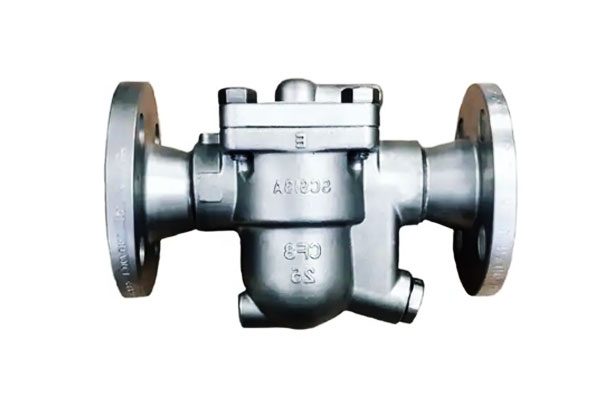
General Process Industry
- Penukar panas
- Steam jackets and reactors
- Process vessels
Makanan & Industri minuman
- Sterilizers, cookers, autoclaves
- Cip (Bersih di tempat) sistem
- Steam tracing of product pipelines
Farmasi & Biotech
- Pure steam sterilization systems
- Clean steam distribution
- Bioreactor heating
Minyak & Gas / Petrokimia
- Reboilers
- Condensate recovery systems
- Line tracing in hazardous zones
Pembangkit listrik (Panas & Nuklir)
- Turbine drain systems
- Feedwater heaters
- Deaerators
Textile & Paper Industry
- Dryers and calenders
- Steam cylinders and pressing machines
- Steam-heated rolls
HVAC and Building Services
- Radiators and convectors
- Humidifiers
- Air handling units
9. Advantages and Disadvantages of Steam Trap
Keuntungan
Efisiensi Energi
By discharging only condensate and retaining live steam, steam traps minimize energy waste, reduce fuel consumption, and improve thermal efficiency in heating processes.
Process Stability
Steam traps maintain optimal heat transfer by preventing condensate accumulation, ensuring consistent temperatures in heat exchangers, reaktor, and other steam-driven equipment.
System Protection
Effective condensate removal reduces the risk of water hammer, korosi, and thermal stress, extending the life of piping, katup, and process equipment.
Pengoperasian Otomatis
Steam trap respond passively to temperature, tekanan, or density changes—requiring no external power or manual intervention—enabling fully automated condensate control.
Improved Start-Up Efficiency
Traps with air-venting capability accelerate system warm-up by removing air and non-condensable gases that hinder steam flow and delay temperature rise.
Fleksibilitas di Seluruh Aplikasi
Available in mechanical, thermodynamic, and thermostatic types, steam traps are suitable for a wide range of pressures (vacuum to 600+ batang), loads, and system layouts.
Facilitates Condensate Recovery
By separating clean condensate from steam, traps enable recycling through condensate recovery systems, saving water, bahan kimia, and treatment energy.
Kerugian
Susceptibility to Failure
Steam trap can fail open (causing live steam loss) or fail closed (leading to flooding) due to erosion, skala, korosi, or mechanical fatigue over time.
Persyaratan pemeliharaan
Routine inspection, pengujian, and cleaning are necessary to ensure performance. Neglected traps may leak unnoticed, reducing energy efficiency and safety.
Application Sensitivity
Improper sizing or incorrect trap selection can cause operational issues, such as underdrainage, steam locking, or excessive cycling under variable loads.
Installation Complexity
Steam traps require specific piping configurations (MISALNYA., correct pitch, elevation, dirt legs, isolation valves) to function reliably and minimize wear.
Limited Cross-Compatibility
Not all trap types are suitable for all applications. Misalnya, disc traps may chatter at low pressure, while float traps may struggle in vertical installations.
Air Venting Limitations (Certain Types)
Beberapa jenis (MISALNYA., inverted bucket, cakram) are less effective at venting air and non-condensable gases, leading to longer startup times or heat transfer inefficiency.
10. Perbandingan dengan katup lain
Steam trap is often misunderstood or miscompared with conventional valves.
While all control fluid flow, steam traps are unique in fungsi, actuation, and response behavior, tailored specifically for steam-condensate separation and energy conservation.
Functional Comparison Table
| Fitur / Fungsi | Steam Trap | Katup globe | Periksa katup | Pressure Reducing Valve (PRV) |
| Tujuan utama | Automatically discharge condensate without losing steam | Manually or automatically throttle flow | Prevent backflow | Maintain constant downstream pressure |
| Media Separation | Ya (differentiates steam, condensate, air/NCGs) | TIDAK | TIDAK | TIDAK |
| Jenis Operasi | Otomatis, self-actuating based on temperature/pressure | Manual or actuator-based | Pasif (flow-actuated) | Otomatis (pilot or spring-controlled) |
| Condensate Discharge | Continuous or intermittent based on type | Tidak berlaku | Tidak berlaku | Tidak berlaku |
| Steam Retention | Yes – key function | TIDAK | TIDAK | TIDAK |
| Air Venting Capability | Ya (in thermostatic/mechanical types) | TIDAK | TIDAK | TIDAK |
| Failure Impact | May cause energy loss or flooding | May cause throttling issues | Allows reverse flow | Pressure instability |
| Maintenance Needs | Periodic testing, inspeksi, strainer cleaning | Seat wear, actuator service | Occasional cleaning | Spring/diaphragm replacement |
| Aplikasi utama | Sistem uap, Penukar panas, tracing, drip legs | Isolation and throttling | Flow protection in pipelines | Kontrol proses, distribusi uap |
11. Kesimpulan
A Steam trap is indispensable in any steam-based thermal system. Proper selection, installation, and maintenance dramatically enhance efisiensi, keamanan, Dan return on investment.
With modern traps offering digital diagnostics Dan remote monitoring, they have evolved from passive mechanical devices to strategic energy assets.
INI: Solusi Pengecoran Katup Presisi Tinggi untuk Menuntut Aplikasi
INI adalah penyedia khusus layanan casting katup presisi, Memberikan komponen kinerja tinggi untuk industri yang membutuhkan keandalan, integritas tekanan, dan akurasi dimensi.
Dari coran mentah hingga tubuh dan rakitan katup mesin sepenuhnya, INI Menawarkan solusi ujung ke ujung yang direkayasa untuk memenuhi standar global yang ketat.
Keahlian casting katup kami termasuk:
Casting investasi untuk tubuh katup & Memangkas
Memanfaatkan teknologi casting lilin yang hilang untuk menghasilkan geometri internal yang kompleks dan komponen katup toleransi ketat dengan lapisan permukaan yang luar biasa.
Casting pasir & Casting cetakan cangkang
Ideal untuk tubuh katup sedang hingga besar, flensa, dan topi-menawarkan solusi yang hemat biaya untuk aplikasi industri yang kasar, termasuk minyak & pembangkit gas dan listrik.
Pemesinan presisi untuk katup fit & Integritas segel
Pemesinan CNC kursi, utas, dan wajah sealing memastikan setiap bagian cor memenuhi persyaratan kinerja dimensi dan penyegelan.
Rentang materi untuk aplikasi penting
Dari baja tahan karat (CF8/CF8M/CF3/CF3M), kuningan, Besi ulet, untuk dupleks dan bahan paduan tinggi, INI coran katup pasokan yang dibangun untuk berkorosif, bertekanan tinggi, atau lingkungan suhu tinggi.
Apakah Anda memerlukan steam trap yang dirancang khusus, katup sumbat, katup globe, katup gerbang, atau produksi coran katup industri dengan volume tinggi, INI adalah mitra tepercaya Anda untuk presisi, daya tahan, dan jaminan kualitas.
FAQ
What is the difference between a float trap and a thermostatic trap?
Float traps (mekanis) use buoyancy to drain condensate and work best for high loads.
Thermostatic traps use temperature sensitivity to vent air and condensate, ideal for low-pressure or temperature-critical systems.
How often should steam traps be inspected?
Monthly visual checks, quarterly ultrasonic/thermal testing, and annual disassembly. High-criticality systems (MISALNYA., Pengolahan makanan) should be inspect monthly.
Can steam traps handle flash steam?
Ya, thermodynamic (cakram) traps are designed for flash steam, using its velocity to actuate valves. Mechanical traps also handle it but may require larger sizing.
What’s the typical lifespan of a steam trap?
5–10 years for mechanical traps (F&T, inverted bucket); 3–7 years for thermostatic/disc traps. Perawatan yang tepat memperpanjang umur hingga 30–50%.
How do I size a steam trap for my system?
Calculate condensate load (kg/h) using heat transfer equations (MISALNYA., 1 kg steam = 2,200 kJ heat; A 100 kW heater produces ~160 kg/h condensate).
Select a trap with 1.5× this capacity to account for surges.
What is a Steam Trap?
A steam trap is a specialized automatic valve used in steam systems to efficiently remove condensate (water formed when steam cools) and non-condensable gases like air, while preventing the loss of valuable live steam.
By distinguishing between steam and condensate based on differences in temperature, kepadatan, or velocity, steam traps ensure optimal heat transfer, improve energy efficiency, and protect equipment from water damage and corrosion.

